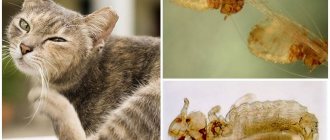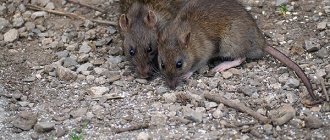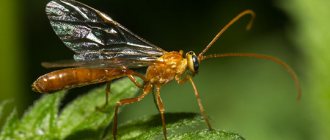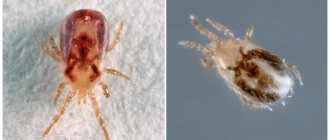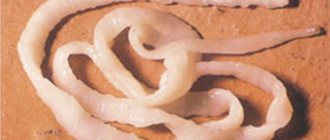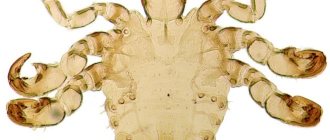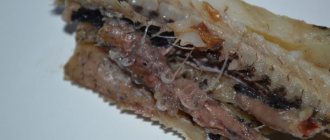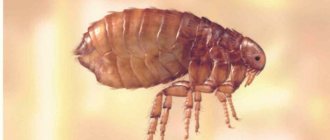Subcutaneous parasites can cause a lot of trouble and cause serious complications that are dangerous to health. Parasites can enter the human body and live anywhere - in internal organs, muscles, skin. An extremely common option is parasites that burrow under the skin. What diseases do subcutaneous parasites cause in humans, what complications can they cause and how to get rid of them - let’s try to figure it out.
The invisible enemy
There are a lot of parasites that affect the skin. They can be cutaneous or subcutaneous. Cutaneous lice include common lice, bedbugs, and fleas. But parasites living on human skin do not cause disease and simply feed on human blood.
Much more unpleasant and dangerous are those parasites that penetrate into the thickness of the skin. At the same time, they not only feed on it, but also use it to breed offspring. Getting rid of them is much more difficult than getting rid of cutaneous ones.
It is very important to diagnose the disease as early as possible and begin its treatment.
Such creatures living under the skin lead to the development of parasitic dermatoses.
These include:
- filariasis;
- scabies;
- dracunculiasis;
- hookworm disease;
- schistosomiasis;
- cysticercosis.
Some protozoa, such as Trichomonas, can also cause skin lesions. Such dermatoses have to be treated long and hard - the main problem here is to make the correct diagnosis. And diagnosis is often difficult, since the symptoms of diseases may resemble damage to internal organs or an allergic reaction.
It is possible to defeat parasites!
Antiparasitic Complex® - Reliable and safe removal of parasites in 21 days!
- The composition includes only natural ingredients;
- Does not cause side effects;
- Absolutely safe;
- Protects the liver, heart, lungs, stomach, skin from parasites;
- Removes waste products of parasites from the body.
- Effectively destroys most types of helminths in 21 days.
There is now a preferential program for free packaging. Read expert opinion.
Read further:
Treatment of head lice and nits at home with folk remedies
How to get rid of nits at home, traditional methods
Shampoo for head lice: list of the best products for preventing head lice
How to treat Giardia in a child from 2 to 15 years old: with medication and folk remedies
Toxocariasis in children: what is it, treatment with medication and folk remedies
How to treat pubic lice with medication and folk remedies
Dracunculiasis - unpleasant cyclops
This parasite is otherwise called Guinea worm. Dracunculiasis is caused by round subcutaneous helminths, which in adulthood can be frightening in size. Females of Dracunculus medinensis grow to 32–120 cm as adults.
In addition to humans, they can parasitize dogs and cats. In Eurasia, guinea worm is found in Central Asia. But most often it is typical for countries with a tropical climate. This is where tourists get infected.
This parasite is otherwise called Guinea worm. Dracunculiasis is caused by round subcutaneous helminths, which in adulthood can be frightening in size
They enter the body along with raw water. After 1–2 weeks, the larvae begin to move through the body and after 48 days they enter the subcutaneous areas. Full development of individuals occurs after a year. Most often, these parasites settle in the leg area.
As a result of the vital activity of the larvae, a swollen ridge in the form of a cord forms on the skin, and then a bubble that can grow up to 7 cm. It can burst if it comes into contact with water, and then new larvae appear.
Complications of the disease are:
- development of contractures (immobility) of joints;
- joint inflammation;
- gangrene;
- blood poisoning - sepsis.
Due to the spread of infection, abscesses and phlegmons can form on the skin, which easily lead to general blood poisoning.
Treatment: to get rid of guinea worm, you need to remove the parasite from the skin tissue. However, it can be removed in several stages if its length is very large. The main thing is not to tear the parasite.
How to avoid getting sick: do not drink from open sources of water and avoid swimming in ponds.
Dracunculiasis
Subcutaneous parasites (guinea worms) can cause a disease called dracunculiasis. How does a person become infected? Everything is very simple, dirty water may contain small crustaceans that are already infected with parasites. When consumed, the crustaceans die, and the larvae are released and begin to actively develop.
This disease is common in areas where there is no access to clean drinking water. Worms live under human skin. After entering the body, the larvae strive to penetrate the stomach or intestines. Afterwards they are able to penetrate the abdominal and retroperitoneal cavity. There they develop for three whole months without showing themselves in any way. After this period, reproduction occurs (mating of opposite-sex individuals). When fertilization has occurred, the females migrate into the tissues. During this period, a blister appears on the surface of the skin (often on the foot). Within three days it ruptures and the live worm is released. This process is accompanied by a strong burning sensation, and the person is forced to frequently immerse the affected area of skin in water, and this is how it becomes infected.
How to prevent infection? It's simple, you need to purify drinking water using filters and the boiling process.
Dirophyllaria: a ticking time bomb
Parasites that live under human skin are considered extremely unpleasant, capable of settling not only under the skin, but also in the eyes. This is the so-called dirofilaria, the females of which reach a length of 15–30 cm, and the males 5–10.
Infection occurs through mosquitoes. The fact is that the carriers of parasites are dogs and cats, and the carriers are mosquitoes, which, by biting dogs, transfer microfilariae larvae from them to humans. Full development already occurs under human skin, which takes a very long time - the incubation period can last several years.
Heartworms settle under the skin. But sometimes they can live in the eyes, leading to visual impairment and even blindness.
Heartworms settle under the skin. But sometimes they can live in the eyes, leading to visual impairment and even blindness. It is believed that in 1/6 of all cases of removal of the eyeball it is due to damage by this parasite. Under the skin, due to the penetration of the larva, a compaction is formed, which gradually grows and can take on the size of an egg. The seal turns red and itches. It contains a folded heartworm.
Treatment: the abscess is opened surgically.
How to avoid getting sick: you need to use repellents.
Scabies mite: a well-forgotten old thing
The scabies mite causes scabies, a disease that was well known 50 years ago.
The Sarcoptes scabiei mite, with a microscopic size of 0.3–0.4 mm, settles in the deep layers of the skin. He begins to eat through the passages in it, thereby causing unbearable itching.
He doesn't like the top layer of skin because it is too dense and hard. The tick feeds on human epithelium and lays eggs in it. During her two-month life, the female lays dozens of eggs.
The favorite places for these subcutaneous parasites to be affected are the hands, soles of the feet, buttocks, folds, sides of the thighs, mammary glands, armpits, and genitals. In children, mites often settle in the hair.
The scabies mite causes scabies, a disease that was well known 50 years ago.
It is easy to identify scabies: scabies in the form of lines are visible on the skin (they are clearly visible after treatment with iodine solution), itching and crusts appear at the scratching sites, blisters-papules, rashes, especially in the elbow area. The itching is worse at night. Complications of scabies - the appearance of boils, dermatitis, eczema, impetigo (blistering rashes). Exacerbations occur in the autumn months.
Infection occurs through direct contact, use of shared hygiene items, and through clothing.
Treatment: you can get rid of scabies mites using sulfur ointment, which should be used for a week. Good results are obtained by using sulfur soap and hydrochloric acid solution. This procedure is repeated every three days. To cleanse the skin, take soap and soda baths and use salicylic ointment.
Antibiotics are used only in cases of extensive lesions and infection of the skin.
It is important to carry out complete disinfection - boil all bedding and clothing. Then you need to iron everything on both sides.
How to avoid getting sick: Practice good hygiene, wash your hands regularly and avoid contact with infected people.
Skin fungus
general description
Fungal diseases, medically called mycoses, have become widespread in our time.
Fungal diseases of the body belong to superficial mycoses, among which are:
- Keratomycosis is a fungal infection of the upper layer of skin. This group includes pityriasis versicolor, nodular trichosporia, erythrasma, axillary trichomycosis;
- Dermatomycoses are deeper lesions of the skin caused by dermatophytes, yeasts or molds. Among them are epidermomycosis, microsporia, rubromycosis, trichophytosis, favus;
- Candidiasis is a pathological lesion of the skin and mucous membranes by yeast-like fungi Candida albicans; distinguish urogenital, oral candidiasis, skin and nail candidiasis, internal organ candidiasis;
Routes of infection
The fungal parasite enters the skin of a healthy person through contact with a sick person or indirectly through shared accessories: combs, towels, manicure or pedicure instruments, shoes, etc. You can also become infected when visiting a bathhouse, swimming pool, sports club and other public places.
Symptoms
Keratomycosis is characterized by the localization of fungi in the stratum corneum of the epidermis without affecting the skin appendages, in the form of light brown spots, sometimes with a pinkish tint, with noticeable pityriasis-like peeling, most often on the neck, back, chest and shoulders. There are no inflammatory reactions of the skin during the period of exacerbation, as well as feelings of discomfort.
Dermatomycosis is characterized by the following symptoms: red round spots on the skin; skin diaper rash, peeling; deformation, change in nail structure; changes in the area of interdigital folds; itching in the affected area.
Candidiasis causes different symptoms depending on the location.
Drug treatment
Fungus on the body should be treated comprehensively. In order for a doctor to prescribe adequate therapy, it is necessary to undergo a study to determine the type of microorganism. Fungal treatment includes:
- Local use of antimycotics (Mikozolon, Mikoseptin, Mikospor, Mikozoral, Nizoral, Kanizon, Mikozan, Mifungar, Lamisil, Mikoterbin, Candide, Triderm, Ekalin, etc.);
- Systemic administration of antimycotics with fluconazole, itraconazole, miconazole, ketoconazole, clotrimazole, econazole or other imidazole and triazole derivatives (Diflucan, Forcan, Mikosist, Nizoral, Flucostat, etc.);
- The use of antifungal antibiotics of the polyene series (nystatin, natamycin, amphotericin, levorin);
- Use of glucocorticosteroid drugs;
- Taking antihistamines, immunomodulators and multivitamins.
- Physiotherapeutic procedures (medicinal electrophoresis, pulsed magnetic therapy, UHF therapy).
Treatment with folk remedies
- Coffee baths can combat fungus on the hands, feet and body (only natural coffee, not instant!);
- An ointment made from butter with chopped garlic is applied to the affected areas of the body;
- Wipe the affected areas on the body twice a day with a 20% alcohol solution of propolis;
- Do the same with onion juice for 3-5 days;
- Onion, mashed into a paste, is placed between the fingers for 30 minutes, after which the feet are washed in warm water;
- Lubricate the affected skin with alcohol tincture of garlic;
- Rub lemon into folds of skin twice a day for a week.
Filariasis: southern guest
These parasites under human skin - thread nematodes - are common in Africa, Asia, and South America. You can become infected after being bitten by bloodsucking insects. The disease takes a long time to develop (up to 7 years).
Initially, urticaria and fever may appear, which are almost never paid attention to. After a few years, skin lesions appear - eczema, ulcers, papules, warts, rashes, nodules. If drowsiness, malaise, fever, and headache are observed, then the diagnosis becomes easier.
These parasites under human skin - thread nematodes - are common in Africa, Asia, and South America
Complications of the disease can include arthrosis, vision problems (including glaucoma and cataracts).
Treatment: ditrazine (hetrazan) is used.
How to avoid getting sick: protect yourself from insect bites.
Schistosomiasis
Subcutaneous parasites are very dangerous. As mentioned above, they can form entire colonies. So schistosomiasis is caused by a whole group of parasites. It is very important that they lay eggs that have spines. That is, they can easily enter any part of the human body:
- bladder;
- liver;
- spleen;
- uterus;
- circulatory system and so on.
Another danger is that blockages can form in areas of accumulation. As a result, tumors, cysts and the like are formed. Schistosomes are associated with tropical climates. They enter the external environment from the human body through feces and urine. After going through some stages of maturation, the larvae look for a new host and make their way into his body directly through the skin. Their task is to get to the right side of the heart. There the schistosome larva matures and after a month of staying in the human body is ready to lay eggs.
Symptoms of the gastrointestinal form of the disease:
- abdominal pain;
- intestinal disorder;
- flatulence;
- bleeding;
- weight loss.
Symptoms of the genitourinary form:
- in women, disruption of the menstrual cycle;
- miscarriages;
- in men, sexual weakness;
- bloody discharge in the urine and so on.
Symptoms are common to all types of disease:
- rash;
- itching;
- fever;
- headache;
- diarrhea;
- blood or mucus in stool;
- depression;
- weakness;
- fatigue and so on.
Schistosomiasis: skin at risk
Schistomatosis is caused by helminths that live in water. You can become infected with it by swimming in rivers and lakes, mainly in Asian and African countries.
Urogenital schistosomiasis affects the skin and genitourinary organs. The main manifestation is dermatitis, itching, rashes. Schistomatosis can be indicated by night sweats and an increase in the size of the liver, signs of kidney damage.
Urogenital schistosomiasis affects the skin and genitourinary organs
Treatment: antimony preparations are successfully used.
How to avoid getting sick: do not swim in stagnant bodies of water in tropical countries and drink unboiled water.
Cysticercosis: pork tapeworms
Cysticercosis is caused by helminths - the larvae of pork tapeworms. These skin parasites in humans develop as a result of ingestion of parts of the tapeworm with food or water.
They can settle in different parts of the body - in the brain, eyes, internal organs, muscles and skin.
Parasites living under the skin develop over the years. Their presence may be indicated by painless swellings and neoplasms that become dense over the years.
Their location is in the area of the shoulders, chest, and palms. Sometimes urticaria develops.
Treatment: surgical removal and use of antiparasitic drugs.
How to avoid getting sick: do not eat raw meat, do not swim in contaminated bodies of water, follow the rules of hygiene.
Subcutaneous parasites can cause a lot of trouble and cause serious complications that are dangerous to health. Therefore, it is very important to diagnose the disease as early as possible and begin its treatment.
Danger to people
Subcutaneous parasites in humans, the symptoms and photos of which will be discussed further, cause varying degrees of damage to the epidermis. The most common signs are:
- irritation;
- itching;
- ulcers;
- inflammation;
- hair loss.
Now we propose to consider what creatures can live on the skin and under its covers. All this is clearly presented in the table below.
| Simple organisms | Representatives of this class are Leishmania |
| Helminths | This includes a whole list of organisms, including guinea worms, gnathostomes and others |
| Insects | This group includes varieties of fleas |
| Ticks | There is a wide variety of them |
Many people mistakenly assume that these skin problems are caused by poor hygiene. Not at all, the reasons for their appearance are other situations:
- eating raw foods (and also water);
- eating unprocessed and unwashed foods (many people have the habit of eating vegetables, fruits or berries straight from the garden or tree);
- insect bites;
- close contact with an infected person.
Why are subcutaneous parasites dangerous for humans? They are the cause of some diseases.
| Pancreatitis | This is an inflammation of the pancreas. What is the cause of the disease? In most cases, the intestines are damaged by parasites by penetrating the pancreatic duct. |
| Psoriasis | It is a non-infectious chronic skin disease that can occur as a result of exposure to many factors. The theory of the influence of parasites also exists. |
| Eczema | These are non-contagious and varied rashes on human skin. With this disease, the victim experiences burning and itching. |
| Diabetes | This is a deficiency of the hormone insulin, which is produced by the pancreas. As a result of its deficiency, a persistently elevated level of glucose in the blood is observed. One of the causes of the disease is intestinal damage by parasites. It is also worth noting the fact that people suffering from psoriasis also have diabetes mellitus in 99% of cases. |
